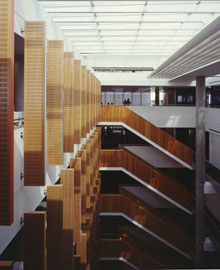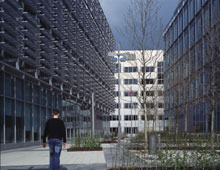BBC's newest building in White City
It
opens in September as part of the London Open House weekend.
The BBC opens its newest building to the public as part of the London Open House Weekend, Saturday 18 September 2004. The Media Centre, part of the BBC's new Media Village in White City, will offer visitors a glimpse of the BBC of the 21st century when it throws open its doors for a day of free tours this September.
There will be tours taking visitors behind the scenes of the new building for the very first time on Saturday 18 September as part of the London Open House Weekend, a city-wide event celebrating the capital's diverse architecture.
Officially opened by Jonathan Ross in May this year, the Media Centre was designed by distinguished architects Allies and Morrison, and is part of the BBC's ambitious new project to create cutting-edge and inspirational buildings and spaces that are accessible and welcoming to the public.
The tours - operating every 30 minutes from 10am-5pm (last tour leaves: 4.30pm) on a first come, first served basis - will give visitors the chance to experience first-hand the architects' creative vision, explore the site's exciting contemporary art and discover how the BBC's Media Village is rejuvenating the local area.
Among the building's striking public artworks are Japanese artist Yuko Shiraishi's mural and colour schemes, and collaboration between Poet Laureate Andrew Motion and graphic designer John Morgan. As part of a wider project, "Voices of White City", the pair have created a poetic work on broadcasting that is permanently inlaid in the surface of the cobbled street in front of the Media Centre.
Just down the road, the world famous broadcasting hub BBC Television Centre will also be offering free tours guided by the award-winning BBC Tours team on Saturday 18th September. Tours will be running every 10 minutes from 10am-5pm (last tour leaves: 5pm and tours lasting 50 minutes).
Visitors to the Centre, designed by renowned architect Graham Dawbarn in the Sixties, will get a chance to see John Piper's distinctive mural and TB Huxley-Jones's celebrated sculpture of Helios, as well as getting a sneak peek behind the scenes at the famous studios where programmes such as Blue Peter and Top Of The Pops are made. And, in the year in which Doctor Who returns to our screens, fans will be able to get up close to the Doctor's own compact home, the Tardis, a true architectural marvel!
BBC Bush House, in The Strand, completes the BBC's Open House Weekend hat-trick with 30-minute tours every 10-15 minutes on Saturday 18 September (tours from 10am - 4.30pm, last tour at 4pm). The stunning home of the BBC World Service was built in the Twenties by American businessman Irving T Bush as a trade centre. Leading the way in construction and design, it was one of the first buildings in London to feature central courtyards to bring light to its back offices. Its galleried show fronts, marble-clad public areas and sweeping staircases maintain their splendour today.
22/8/04
Related links
| Related Links | |
| London
Open House BBC Television Centre Tours |
|
| Participate | |
| Sign
up for our free weekly newsletter Comment on this story on the |
|
| Factsheet | |
|
|

